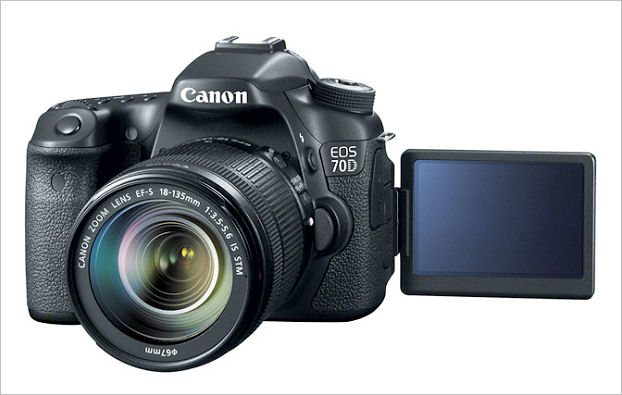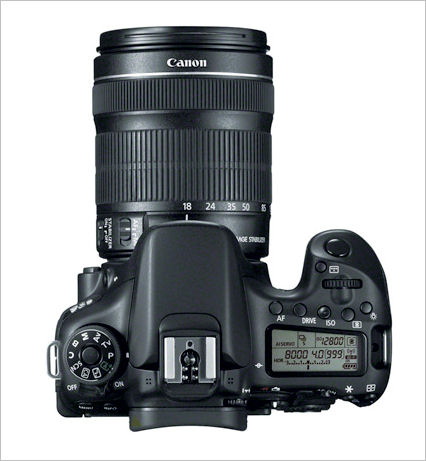

Canon EOS 70D 20.2MP DSLR

UPDATE: See also A hands-on look at the Canon EOS 70D
Canon today released details of the new Canon EOS 70D, the successor to the EOS 60D. The major new feature is the use of an all new 20.2MP "Dual Pixel" CMOS sensor in which each pixel can simultaneously be used for imaging and phase detection AF, permitting vastly better AF in Live view and video modes.
Here are some of the other features of the Canon EOS 70D
- 20.2MP APS-C '"Dual Pixel" CMOS sensor
- DIGIC 5+ image processor
- 7fps continuous shooting
- Buffer for 65 JPEG or 16 RAW images
- ISO 100-12800 with expansion to ISO 25600
- 19 zone AF with all points cross-type, sensitive to -0.5 EV
- 'Silent' shutter mode
- 1080p at 30fps video
- Socket for external stereo microphone
- Single-axis electronic level
- 63-zone iFCL metering system
- 98% viewfinder coverage with 0.95x magnification
- Tilt and swivel touch sensitive, 1040k dot 3" LCD
- Single SD/SDHC/SDXC card slot
- Built-in Wi-Fi
- Built-in flash with ability to wirlessly control compatible off camera speedlites
- AF microadjustment
- In-camera HDR and Multiple Exposure modes (JPEG-only)
- 'Creative Filters' which can be previewed in live view

Physically the EOS 70D closely resembles the EOS 60D. There are some minor differences but nothing of any real significance.

As I said earlier, the "dual pixel" CMOS sensor is the major new feature of the 70D, and I presume a similar sensor will be found on Canon's future DSLRs. Rather than just having a few phase sensitive pixels in the sensor (which is the case with the T5i for example) with, it seems that every pixel location is actually comprised of two photodiodes, making 40.4 million photosensitive sites in all. In imaging mode the output from each pair of photodiodes is combined to form a 20.2 million pixel image. However the left and right halves of each composite pixel can also be used for phase detection autofocus. It seems that the phase detection AF system will be actually active over about 80% of the height and width of the sensor, even though all the pixels are dual.
The live view/video phase detection system used on the EOS T5i uses dedicated phase detection pixels with half of each pixel blocked off and none used in image recording. That results in a loss of sensitivity and the need to interpolate intensity levels at the "missing" pixel locations. The new "dual pixel" system does not suffer from either of these iasues.
Assuming the system works "as advertised", this should give vastly improved autofocus in Live view and Video modes and enable much faster and more accurate focus tracking on moving subjects when shooting video. The EOS 70D also has a conventional separate phase sensitive detection AF system (in fact the system used in the EOS 7D as far as I can tell) for use in normal still imaging.
Not all lenses will provide full phase sensitive AF capability in Live View and Video modes. Some older lenses may have limitations. Here's a list of the lenses which Canon say have some limitations:
|
|
|
The characteristics of the sensor (noise, dynamic range etc.) are unknown at this point but I'm sure that won't be the case for long. The EOS 70D has a native ISO range of 100-12800 with expansion to 25600, and that's one stop more than the EOS 7D, so for the time being it's probably reasonable to assume that the new sensor has similar or better noise characteristics the the existing 18MP sensors that Canon is using in their APS-C DSLR line. Time will tell on that score.
It's not 100% clear yet if the 70D has complex AF capability of the EOS 7D even though it seems to use the same (or similar) AF hardware. I suspect it may not have all the sophisticated tracking mode options of the 7D, but so far no instruction manual is available detailing the AF system modes of the 70D.
The EOS 70D has built in WiFi (which appears to be similar to that in the EOS 6D), but unlike the EOS 6D it does not have built in GPS. Maximum frame rate is 7fps, slightly slower than the 8fps of the EOS 7D.
Scheduled shipping date is September 2013 and the price will be $1199 for the EOS 70D body only, $1349 with the EF-S 18-55mm f/3.5-5.6 IS STM lens and $1549.00 with the EF-S 18-135mm f/3.5-5.6 IS STM.
UPDATE: See also A hands-on look at the Canon EOS 70D
Here are links to:
The Canon EOS 70D can be ordered here:
- EOS 70D Body only (Adorama)
- EOS 70D body with 18-55mm f/3.5-5.6 STM Lens (Adorama)
- EOS 70D body with 18-135mm f/3.5-5.6 STM Lens (Adorama)
